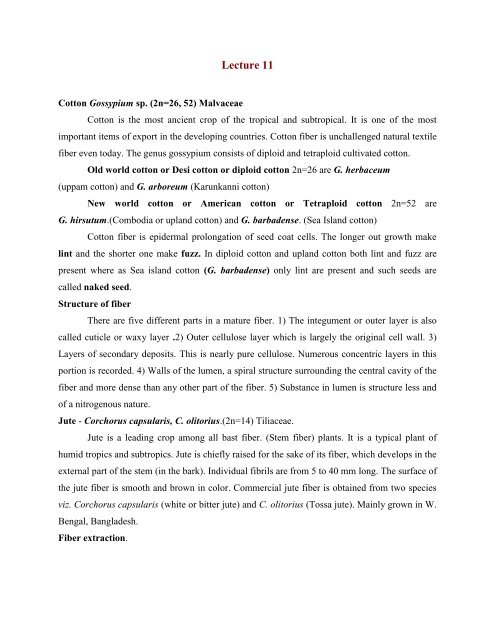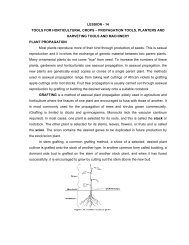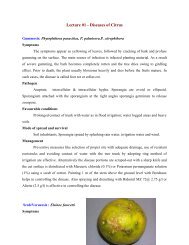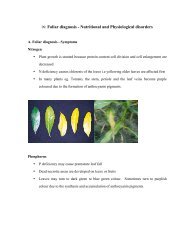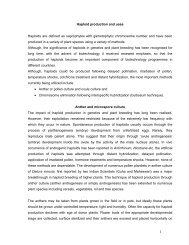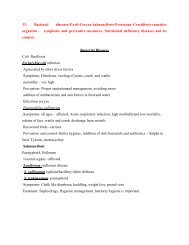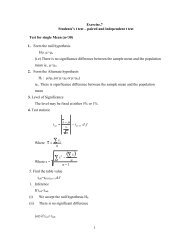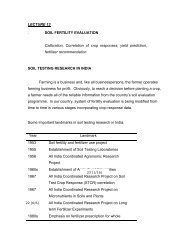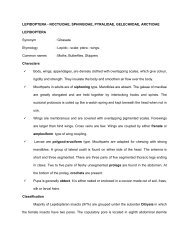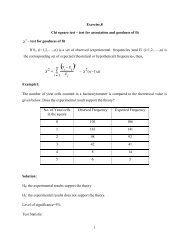You also want an ePaper? Increase the reach of your titles
YUMPU automatically turns print PDFs into web optimized ePapers that Google loves.
<strong>Lec</strong>ture <strong>11</strong>Cotton Gossypium sp. (2n=26, 52) MalvaceaeCotton is the most ancient crop of the tropical and subtropical. It is one of the mostimportant items of export in the developing countries. Cotton fiber is unchallenged natural textilefiber even today. The genus gossypium consists of diploid and tetraploid cultivated cotton.Old world cotton or Desi cotton or diploid cotton 2n=26 are G. herbaceum(uppam cotton) and G. arboreum (Karunkanni cotton)New world cotton or American cotton or Tetraploid cotton 2n=52 areG. hirsutum.(Combodia or upland cotton) and G. barbadense. (Sea Island cotton)Cotton fiber is epidermal prolongation of seed coat cells. The longer out growth makelint and the shorter one make fuzz. In diploid cotton and upland cotton both lint and fuzz arepresent where as Sea island cotton (G. barbadense) only lint are present and such seeds arecalled naked seed.Structure of fiberThere are five different parts in a mature fiber. 1) The integument or outer layer is alsocalled cuticle or waxy layer .2) Outer cellulose layer which is largely the original cell wall. 3)Layers of secondary deposits. This is nearly pure cellulose. Numerous concentric layers in thisportion is recorded. 4) Walls of the lumen, a spiral structure surrounding the central cavity of thefiber and more dense than any other part of the fiber. 5) Substance in lumen is structure less andof a nitrogenous nature.Jute - Corchorus capsularis, C. olitorius.(2n=14) Tiliaceae.Jute is a leading crop among all bast fiber. (Stem fiber) plants. It is a typical plant ofhumid tropics and subtropics. Jute is chiefly raised for the sake of its fiber, which develops in theexternal part of the stem (in the bark). Individual fibrils are from 5 to 40 mm long. The surface ofthe jute fiber is smooth and brown in color. Commercial jute fiber is obtained from two speciesviz. Corchorus capsularis (white or bitter jute) and C. olitorius (Tossa jute). Mainly grown in W.Bengal, Bangladesh.Fiber extraction.
The ideal phase of harvest is when the plants are in small pods. Harvested plants arebundled and staked for the withering of leaves. After 2 to 4 days the leaves shed and the bundlesare then steeped in water.SteepingIt is a process of immersing the bundles in water. After 2 to 4 days the tissues and cellsrupture. This facilitates the entry of micro organism into stem.RettingIt is a process by which harvested stems are steeped in water so that the fiber in the stemget loosened and separated from the woody stalk due to the removal of protein, gums and othermucilaginous substances by the micro organisms. Fiber yield is 6% of the fresh stem weight.Fiber QualityJute fiber is fine and silky but less stronger then many other fiber.Mesta Hibiscus cannabinus (2n = 36 ) MalvaceaeMesta fiber is a valuable fiber probably next to jute. This crop is successfully grownthroughout tropics and subtropics. Bast fiber is obtained from the stem similar to jute.Sun hemp. Crotalaria juncea. 2n=16 FabaceaeSunnhemp is another source of bast fiber, grown in tropical countries. It is also grown asfodder and green manure. The fibers are stronger than jute but lighter in color and more enduringthan jute. They are long strands of fiber of about 4 to 5 feet in length and yellow to green incolor. Fiber is obtained by retting.Sugars(Sugar cane Saccharum officinarum (2n=80) Poaceae.)Sugar cane is a perennial gigantic grassy plant of Poaceae family. It is extensively grownin India, Cuba, Hawaii W.Indies.There are 5 species of sugarcane of which three are cultivated and two are wild species.1. Saccharum officinarum. Noble cane (2n=80). Large barreled, low fiber, high sugarcontent, susceptible to diseases and pests.2. S. barberi. Indian cane (2n=82-124) Intermediate between noble and wild canes.Small barrel, internodes spindle shaped, high fiber content, resistant to diseases.3. S. sinense. Chinese cane (2n=<strong>11</strong>8) Vigorous thin grassy form resistant to drought,pest and diseases. Fair amount of sucrose content.
4. S. spontaneum. Wild cane (2n=40-128). Vigorous than grassy form. Virtually nosucrose, resistant to drought, pest and diseases.5. S. Robustum. Wild cane (2n=60-194) Thick stock low sugar content, diseaseresistant.The above 5 species are important for the improvement of sugar cane. They all inter crossfreely.Inflorescense is panicle. It is also called Arrow.NobilizationBack crossing of F1 with S. officinarum ( noble cane)Forage CropsThe term forages is used broadly to mean all the plant constituents that are eaten byherbivores, including that are grazed (pastures) and those that are cut and fed such as fodder.Crop residues such as straw and the foliage of trees and shrubs also fall within this broaddefinition.Fodders- Plants, which are, cultivated as forages crops and they are cut and fed to animals installs.Pastures- grasses and legumes are grown in pasture lands where the animals are led to graze.Forages can broadly be classified into three groups. viz. grasses, legumes and non legumes.Grasses. Annual grass – Maize, sorghum, and cumbu.Perennial grass.—B.N. and N.B, hybrids.Legumes Annual Cowpea, cluster bean.Perennial Lucerne, Sirato, DesmanthusNon legumes. – Fodder beet, Fodder radish.GrassesNapier grass - Pennisetum purpureumIt is a tall perennial grass forming very thick clumps, tillering is heavy. It comes up wellin both under tropical and temperate regions. It comes well in any soil condition and alsoresponds to sewage irrigation 6-8 harvests can be taken in a year. The grass withstands droughtfor short spell and regenerate with rains.Pearl millet Napier (Bajara - Napier)
They are very vigorous in their growth and adopted for varying climatic and soilconditions. They give heavy yield higher than Napier. They are more nutritious, palatable,succulent, juicy and less fibrous. They tiller profusely have luxuriant growth and responds tohigher level of nitrogen.Guinea grass- Panicum maximumIt is the most popular grass with heavy tillering, forming big clumps with longinternodes, slender and glabrous. It comes up well in tropical condition with moist climates.Under cultivation it can be grown in any soil. It requires sufficient moisture but cannot withstandwater logging. It responds to sewage irrigation. It can be harvested once in 25 to 30 days interval.The crop can be allowed in the field for several years. Dry matter content is 15- 20% Protein 6-8% free from all toxic principles.Buffel grass- Cenchrus ciliarisIt is an important perennial pasture grass and grows well in a great variety of soil andclimate. It is a perennial grass with underground rhizomes. They are hardy and drought resistantand have quick regeneration capacity. It gives the highest forage yield among the grasses grownunder rainfed condition. Aerial branches tufted, leaf sheath compressed with hairs raceme ofspikes sessile spikelets, no lodicules.Johnson grass- S. halapenseIt is native of Africa. It was taken by colonel Johnson and hence named after him. InSouth India it occurs both in 2n = 20 & 40 forms. Because of rhizomatous condition it willspread easily. Co. 27 fodder cholam (Co <strong>11</strong> x S. halapense)Legume FodderLucerne / Alfalfa (Medicago sativa)It is also called as queen of fodder or green gold. Lucerne is grown for pastuer, hay,dehydrated meal and for medicinal purpose. It is an important leguminaceous fodder grown as aperennial crop in drier regions and as an annual crop in hot humid regions. It is heat and droughtresistant.Cow pea-Vigna unguiculataIt is the most important leguminous fodder crop during summer and rainy seasonsmainly due to its quick growing habit, high yielding ability and high protein content.
Desmodium- D. tortuosum / intortum is commonly known as green leaf desmodium, is a largestrailing and climbing, perennial rooting at nods and having a deep tap root. It can be harvested 2-3 times . Shade tolerant green manure cum fodder produces profuse seeds.Protein 22%. It is a tropical legume. It grows well in acid soils.Stylosanthus guianensisIt is a summer growing perennial pasture fodder legumes. S.hamata found to thrive inalkaline soils. S.fruiticosa is from India. It is an herb and small shrub. It thrives in light soils dueto its deep rooting system.Tree fodderSubabul- Leucaena leucocephala.Among the browsing leguminous trees it lops the best. It provides economic nutritiousand highly palatable forage to livestock and poultry. It has an amino acid mimosin. Excessfeeding leads to fall of hairs, thyroids gland swelling and stunted growth. Pods can be fed tocattle. Protein 29%.Glyricidia sepiumIt is a medium tall tree grown in tea coffee and coca plantation for shade. It is pruned forgreen manure purpose.Agathi / sithagathi- Sesbania gandiflora and S. sesban.It is a fast growing and leaves are rich in protein and very much relished by all types oflivestock.Erythin- Erythnina indicaIndian coral leaf is a nirogen fixing cumfodder green manure tree suited even to high acidsoil.Green manure and green leaf manureGreen manure is generally a leguminous crop raised in a field and incorporated in situ.E.g. Sunnhemp, daincha.Green leaf manureIt is a practice of cutting and applying them to the fields and ploughing them e.g. Neem,calotropis, glyricidia.Sunnhemp. Crotalaria juncea. Erect herbaceous shrub. Cylindrical stem silkyappearance pods oblong inflated and hairy.
Sesbania speciosa. It was introduced from South Africa. It is a quick growing and attains3-4m in about 4 months. The crop stands drought and to some extent salinity. The stem ispithy but if allowed To grow for more than 4 or 5 months it becomes woody.Daincha. ( Sesbania aculeata)It is aquick growing succulent crop which adpts itself tovarying conditions of soil amd clinmates. It can be grown even under adverse drought, waterlogging condition and salinity.Tephrosia pururea noctiflora. It is a perennial undershrub, growing wild in sandy orgravellywaste places. It ia also grown as and annual crop for green manureNeem. Azadirachta indica. Evergreen tree with plenty of foliage. Loppings once or twicea year.Pungam. Pongamia glabra. A leguminous ever green tree. Lopping is done once or twice a year.


